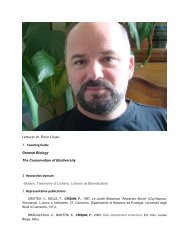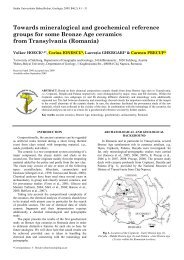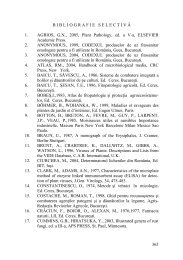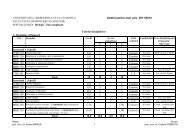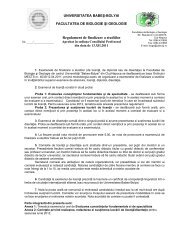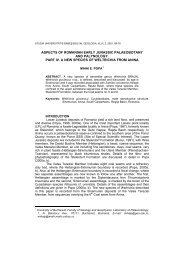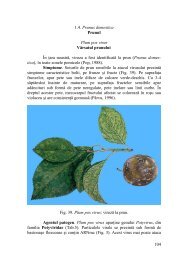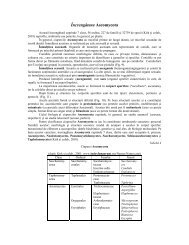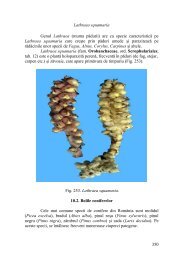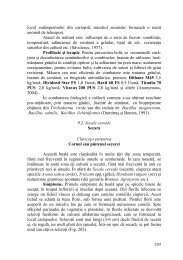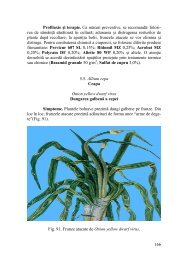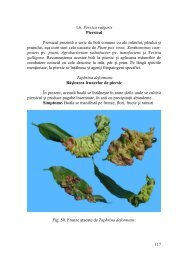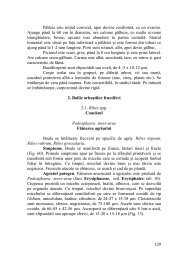upper jurassic and lower cretaceous sedimentary formations from ...
upper jurassic and lower cretaceous sedimentary formations from ...
upper jurassic and lower cretaceous sedimentary formations from ...
You also want an ePaper? Increase the reach of your titles
YUMPU automatically turns print PDFs into web optimized ePapers that Google loves.
STUDIA UNIVERSITATIS BABEŞ-BOLYAI, GEOLOGIA, XLVIII, 2, 2003, 133-139<br />
COPTOCAMPYLODON PANTICI N. MORPHO SP. FROM THE<br />
TURONIAN OF NW SERBIA<br />
DARIVOJKA LJUBOVIĆ-OBRADOVIĆ 1 & RAJKA RADOIČIĆ 2<br />
ABSTRACT. This note describes Coptocampylodon pantici, a new morpho species<br />
<strong>from</strong> Upper Cretaceous outcrops of the Poćuta region (NW Serbia). Based on the<br />
rudists in superincumbent calcarenites <strong>and</strong> planktonic foraminifers of the D. concavata<br />
Zone overlying the calcarenites, the shallow water “Poćuta limestone” is dated Turonian.<br />
The genus Coptocampylodon Elliott is emended.<br />
Keywords: Dasycladales, new morpho species, Turonian, NW Serbia<br />
Introduction<br />
In the Valjevska Podgorina region of NW Serbia, Upper Cretaceous deposits<br />
are found in the Poćuta area <strong>and</strong> in a small tract north of the Sušica river (Fig. 1).<br />
In northern portion of the region the oldest rocks of Cretaceous age are shallow water<br />
Turonian carbonates (“Poćuta limestone”) that rest on karstified Triassic limestones<br />
with minor bauxite occurrences (Pejović <strong>and</strong> Radoičić, 1981). To the south, Upper<br />
Cretaceous rocks are in tectonic contact with older <strong>formations</strong>.<br />
North of the Sušica river, in Ječmenje village, first author (D.Lj.O) sampled ten<br />
metres of a Turonian succession. The <strong>lower</strong>most beds, above the Triassic karstified<br />
surface, contain scarce foraminifers including Vidalina hispanica Schlumberger,<br />
Pseudocyclammina sphaeroidea Gendrot, Moncharmontia apenninica (De Castro)<br />
<strong>and</strong> Nezzazatinella sp.. In addition to these foraminifers the beds making up the fifth<br />
metre contains algae including Falsolikanella hammudai (Radoičić), Terquemella sp.,<br />
Pseudolithothamnium album (Pfender) <strong>and</strong> abundant coptocampylodons, belonging to<br />
a new taxon: Coptocampylodon pantici n. morpho sp.<br />
Elliott (1963) described a new genus <strong>and</strong> species, Coptocampylodon lineolatus<br />
(Problematica) <strong>from</strong> the Lower Cretaceous of Iraq. Fossils of the same type are known<br />
<strong>from</strong> other regions <strong>and</strong> were originally assigned to the Aciculariae, or “microfossils<br />
similar to Aciculariae” (Elliott, 1963; Radoičić, 1968). In his discussion of the possible<br />
biological nature of these fossils, Elliott presumed as the most likely affiliation, their<br />
similarity to the skeletal remains of some small octocorals.<br />
From the Kimmeridgian of NW Germany, Gramann, (1966) described fecal<br />
pellets (“little rods of sediment with longitudinal furrows”) in open nomenclature<br />
under the name Coprulus. Cuvillier et al. (1969) placed Coptocampylodon in the<br />
group Coprulus Gramann. Consequently, Granier <strong>and</strong> Deloffre (1993) excluded<br />
Coptocampylodon lineolatus <strong>from</strong> the Dasycladales.<br />
1 Geozavod – Geological Institute, Karađorđeva 48, 11000 Belgrade.<br />
2 Kralja Petra I 38, 11000 Belgrade, rradoicic@sezampro.yu
DARIVOJKA LJUBOVIĆ & RAJKA RADOIČIĆ<br />
Fig. 1. Distribution of Cretaceous strata in the Poćuta area, NW Serbia (based on: Milovanović &<br />
Ćirić: Geological Map of Serbia, 1968, simplified)<br />
Coptocampylodons were described as solid calcareous bodies with a gently<br />
curved longitudinal axis <strong>and</strong> a grooved outer surface. In thin section, transverse<br />
cuts show stellate structures with truncated rays (Elliott, 1963).<br />
The dasycladalean nature of coptocampylodons was noted in a specimen<br />
of Selliporella neocomiensis (=Triploporella neocomiensis, Radoičić, 1968, Pl. 1, fig. 1;<br />
see: Bucur <strong>and</strong> Săsăran, 2003). Coptocampylodons are actually dislocated tufts of<br />
the secondary laterals of some species of the genera Selliporella, Suppiluliumaella<br />
(Radoičić, 1972, Fig. 1b), Triploporella, <strong>and</strong> probably others as well. Sections similar to<br />
those of the coptocampylodon type are also found in tufts of the primary upwardcurved<br />
laterals of the Permian genus Kochanskyella – K. tulipa (Milanović, 1974).<br />
The holotype of C. lineolatus (Elliott 1963, pl. 46, fig. 4) is an isolated specimen –<br />
the proximal part of a broken R2 tuft. In pl. 46, fig. 6, the surface of the transverse<br />
section of an isolated specimen is shown. It evidently corresponds to the transverse<br />
section of fig. 8, pl. 46. This transverse sections of Coptocampylodon lineolatus<br />
markedly differs <strong>from</strong> a Coprulus (“little rods of sediment …”). The external similarity of<br />
Coptocampylodon lineolatus (longitudinal grooves) with some Coprulus (Gramann,<br />
pl. 1, figs. 1a-4b; Cuvillier et al., pl. 2, figs. 6-9) is a case of homeomorphism.<br />
Paleontological description<br />
Morpho genus Coptocampylodon Elliott, 1963, emend.<br />
Small calcareous bodies which represent dislocated tufts of the elongate<br />
trichophorous secondary laterals of some dasycladalean species, perhaps even of<br />
several genera, which occur as scattered units in sediments.<br />
134
COPTOCAMPYLODON PANTICI N. MORPHO SP.<br />
In addition to the type-species (with 5-8 pores/grooves), other Coptocampylodon<br />
have been described: C. fontis Patrulius <strong>from</strong> the Lower Cretaceous of Romania<br />
(9-15 pores/canals) <strong>and</strong> C. elliotti Radoičić <strong>from</strong> the Albian (revised age!) of the<br />
Mirdita Zone <strong>and</strong> the Outer Dinarides (6-9 pores/canals). Depending on the state of<br />
preservation, in tranverse section the laterals appear as a row of peripheral pores<br />
or, where outer calcification is absent, as a stellate structure with truncated rays.<br />
The space enclosed by the laterals appears in transverse sections as central cavity<br />
(except where the calcareous bodies are completely recrystallized).<br />
Coptocampylodon pantici n. morpho sp.<br />
(Pl. 1, Figs. 1-5, Pl. 2, Figs. 1-4, Pl. 3, Figs. 1, 2)<br />
O r i g i n of n a m e: The species is dedicated to Professor Nikola Pantić<br />
(University of Belgrade) as a tribute to his contributions to the paleobotany <strong>and</strong><br />
geology of Serbia.<br />
H o l o t y p e: Axial section of a calcareous body, with a slightly curved<br />
basal part as shown in Pl. 1, Fig. 4 (arrow), thin section RR465l; Collection R.<br />
Radoičić housed in Geozavod, Geological Institute, Belgrade.<br />
I s o t y p e s: Numerous transverse, oblique <strong>and</strong> longitudinal sections<br />
some of which are illustrated in Pl. 1-3. Thin sections RR4665-4667.<br />
T y p e - l o c a l i t y: Surroundings of the village of Ječmenje, Valjevska<br />
Podgorina, NW Serbia; Gaus Krueger coordinates N 4895680, E 7403140.<br />
D i a g n o s i s: Tufts consisting of four, seldom five fused canals, originating<br />
<strong>from</strong> trichophorous secondary laterals the basal portion of which is slightly curved.<br />
Transverse sections of units with four canals look like a Maltese cross.<br />
The trichophorous shape of the laterals determines the shape of the tuft;<br />
consequently, transverse sections of the basal part are larger (up to 0, 250 mm)<br />
than those that cut it higher. The curve of the tuft is visible only in very few axialsubaxial<br />
sections. Most longitudinal <strong>and</strong> oblique-longitudinal sections cut through<br />
the rectilinear part of the tuft which is at most 0.960 mm long. The calcification of<br />
the tuft surface is seldom preserved.<br />
C o m p a r i s o n s: Coptocampylodon pantici differs significantly <strong>from</strong><br />
species having many more canals. Coptocampylodon pantici may represent tufts of the<br />
secondary laterals of an indeterminate species (genus Triploporella?) that is shown in<br />
Pl. 1, Fig. 6 (here only a calcified axis with a few moulds of primary laterals is preserved).<br />
A g e: The Poćuta limestone is dated Turonian based on the identification<br />
of rudists in the overlying calcarenites <strong>and</strong> of the planktonic foraminifers of the D.<br />
concavata zone in the succeeding pelagic carbonates (Pejović <strong>and</strong> Radoičić, 1968;<br />
Radoičić, 1978, 2003).<br />
Accnowledgements<br />
The authors thank Marc A. Conrad (Geneve), Bruno Granier (Paris) <strong>and</strong><br />
Nestor S<strong>and</strong>er (USA) for their comments <strong>and</strong> English improvement of the manuscript.<br />
135
136<br />
DARIVOJKA LJUBOVIĆ & RAJKA RADOIČIĆ<br />
REFERENCES<br />
Bucur, I.I. & Săsăran, E. 2003: Selliporella neocomiensis Radoicic 1975 (non 1963), nov. comb.<br />
Acta Micropaleont. Sinica, 20, 1, 57-66<br />
Elliott, G.F. 1963: Problematic microfossils <strong>from</strong> the Cretaceous <strong>and</strong> Palaeocene of the Middle East.<br />
Paleontology, Vol. 6, 2, 293-300, London.<br />
Cuvillier, J., Bassoullet, J. P., Fourcade, E. 1969: Coprolithes du Jurassique et du Crétacé d’Espagne<br />
et de quelques autres régions. Revue de Micropaléont., vol. 11, 4, 183-190. Paris.<br />
Granier, B. & Deloffre, R. 1993: Inventaire critique des algues Dasycladales fossiles. II° partie – Les<br />
AlguesDasycladales du Jurassique et du Crétacé. Rev. Paléobiol. 12, 1, 19-65, Genève<br />
Milanović, M. 1974: Kochanskyella (Chlorophyta, Dasycladaceae), a new Permian Genus of the<br />
Mt. Velebit, Croatia. Geološki vjesnik, 27, 127-132, Zagreb.<br />
Milovanović, B., Ćirić, B. 1968: Carte géologique de la R. S. de Serbie. Inst. de rech. géol. et<br />
géoph., Belgrade.<br />
Pejović, D., Radoičić, R. 1981: A contribution to the biostratigraphy of the Poćuta bauxite region<br />
(western Serbia). Glas SANU, Cl. sc. nat. et math. 48, 21-26, Beograd.<br />
Radoičić, R. 1969: Coptocampylodons de certains sédiments jurassiques et crétacés de la<br />
Yougoslavie. Vesnik, ser. A, 27, 191-200, Beograd.<br />
Radoičić, R. 1972: A new Neocomian Dasycladacea Suppiluliuaemella gocanini <strong>from</strong> the environs<br />
of Orahovac (Mirdita Zone). Bull. scient., Cons. des Acad. des Sc. Et des Arts de la RFY,<br />
sec. A, tome 17, 11-12, 364-365, Zagreb.<br />
Radoičić, R. 2003: Permocalculus nikolapantici (Udoteaceae?) <strong>from</strong> the Upper Turonian of the<br />
NW Serbia. Bull. TCXXVIII Acad. Serbe sc. Arts, sc. nat., 42, p. 239-259.<br />
Plate I<br />
Plate II<br />
Plate III<br />
PLATES<br />
Figs. 1-5 Coptocampylodon pantici n. morpho sp.<br />
Figs. 1-3, 5. transverse sections, (circa 140x). Thin sections RR4657, 4655. Fig. 4.<br />
Holotype: axial section (arrow), oblique <strong>and</strong> transverse-oblique sections, in<br />
the <strong>upper</strong> part of the figure: Terquemella sp., Thin section RR4651;<br />
Fig. 6 ?Triploporella, arrows: moulds of primary laterals. (75x). Thin section RR4655.<br />
Figs. 1-4 Coptocampylodon pantici n. morpho sp., oblique, longitudinal <strong>and</strong> transverse<br />
sections, ( 5x). Thin sections RR4657, 4656 <strong>and</strong> 4655 (Terquemella sp. In Fig. 1).<br />
Figs. 1-2 Coptocampylodon pantici n. morpho sp., transverse <strong>and</strong> transverse-oblique<br />
sections, (5x), Thin sections RR4656 <strong>and</strong> 4657.<br />
Figs. 3-8 Falsolikanella hammudai (Radoičić), various sections, (35x), (with C. pantici in<br />
figs. 3, 4 <strong>and</strong> 6), Thin sections RR4655 <strong>and</strong> 4657.
COPTOCAMPYLODON PANTICI N. MORPHO SP.<br />
Plate I<br />
137
138<br />
DARIVOJKA LJUBOVIĆ & RAJKA RADOIČIĆ<br />
Plate II
COPTOCAMPYLODON PANTICI N. MORPHO SP.<br />
Plate III<br />
139



